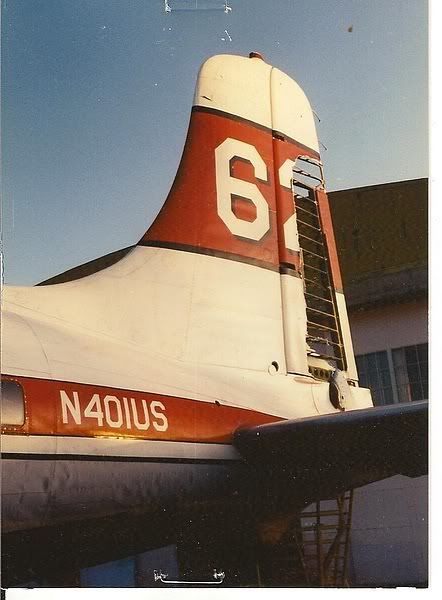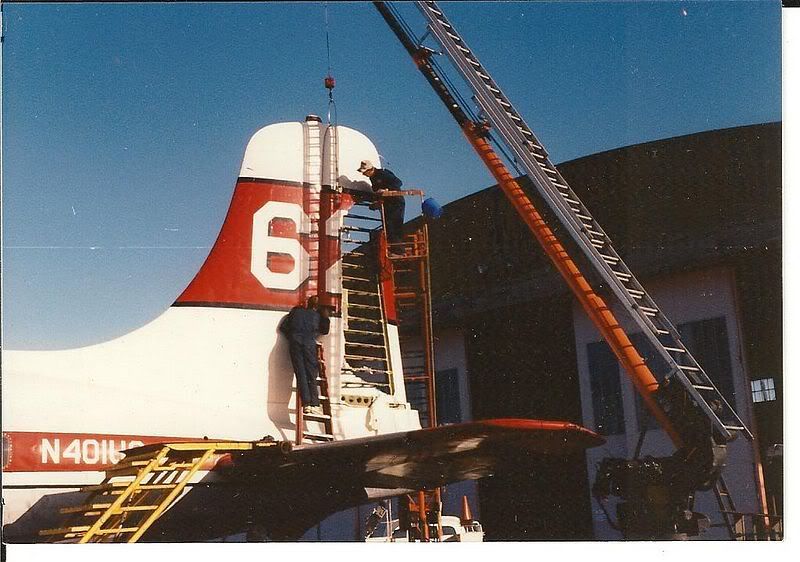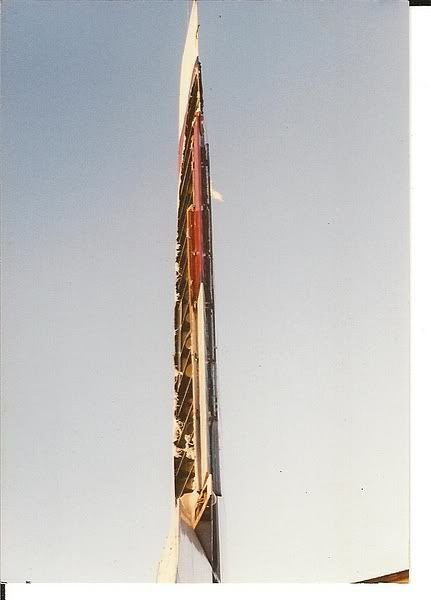I came across a few pictures from an interesting flight in Tanker 62 that took place in either 1992 or 1993 when I was based in Medford on a Fed contract.
I was working out of Redding on a fire in the Hoopa Indian Reservation near the coast in Northern California.The fire was a little closer to Redding than to Medford.On the incident flight,I was supposed to follow in trail of a P-2 that was following the Leadplane on a drop run.As I was just supposed to tag on to the P-2's drop and extend a line,this procedure should have worked,the only real drawback being the strong possibility of getting drift retardant still hanging in the air on the windshields.This is a real concern deep in a canyon with one way out.
As it turned out,that wasn't a problem because the target was very deep into the canyon and the Leadplane and the P-2 started building up too much speed in the steep descent.I had been staying a little high in trail and had just started to slip to lose altitude.This works well with the DC-7 as long as you keep the speed down.Around 100-120 kts IAS works best,but the ASI is wildly inaccurate in a full slip.
When the Lead decided to abort the drop run and go around for another try,I released the rudder deflection to initiate a climb.At that moment there was an audible bang from somewhere aft of the cockpit in T62 followed by uncommanded inputs to the rudder pedals.As we were fairly deep in the canyon and over a river,it wasn't an ideal place for either trouble shooting flight control difficulties or jettisoning the load of retardant (3000 gl/27,000 lbs) as some of the chemicals in the retardant are highly toxic to fish.
The first thing that I did was to look over to my co-pilot,Tim McCoy, with the intention of telling him to quit playing with the rudder pedals.As his eyes looked like a couple of fried eggs and his feet were flat on the floor,I knew that he wasn't making the inputs,which were getting rapid and severe enough to make me worry about taking the tail off of the airplane with aerodynamic flutter.
The first thing that came to mind concerning the cause of the problem was that fabric might be trailing from the rudder for some reason and acting as an unwanted boost tab.I'd had something like that happen in a Twin Beech a year or two earlier when a piece of tape covering the fore and aft stiches on the elevator came loose on top and trailed behind the elevator while flying in heavy rain in a thunderstorm.I ended up landing the Beech with the elevator trim,not knowing what was going on.
I managed to sidestep T62 far enough over toward the canyon wall to jettison the retardant away from the river and slowed down while adding flap to see if I could find a speed that would eliminate the rudder movement.I finally got it to stop completely at 120 kts.I managed a slow climb to above the canyon rim and contacted the Leadplane and told him what was going on.He came over and took a close look at the rudder.He looked at the left side first and said that it looked normal,then switched over to the right side and said that there appeared to be a fist sized hole near the number 6 in the 62 tail number.
I found that if I braced my heels against the skid plate on the floorboard under the rudder pedals I could act as a control lock for the rudder.Doing this,I was able to increase the speed to 160 kts.That's still 40kts slower than normal cruise,but better than 120.I decided to climb to altitude and head for Medford as the people that could do the necessary repairs were at Redmond,which was a 3 hr drive/1+20 hrs flight in a Cessna 206 or a 45 min flight in the DC-7 to get from Redmond to Medford.When I got close to Medford,the situation had settled down and I figured that the next big challenge would be landing the airplane.
So,I figured that I might as well continue on to Redmond where I had the best chance of getting the rudder patched and getting back into service with the least delay.I ran into a little turbulence crosing the Cascade Mountains between Medford and Klamath Falls.That dropped a wing and upset my "control lock" for a minute or two with some tail wagging,but it was much less severe than it had been earlier.
The descent and landing was anti-climactic with the exception of my trying to use aerodynamic braking by holding the nose fairly high during the initial rollout.There was a bit of a crosswind and when I kicked in some rudder to keep the nose straight,nothing happened.I tried more rudder without much happening,so I just let the nosewheel drop to the runway and reversed for a normal landing.
I taxied up to Butler's maintenance hangar and parked.One of the mechanics,my current co-pilot Ron Carpinella,chocked the left main wheel and went back to look at the rudder.I was still in the cockpit going through the After Shutdown Checklist when Ron walked by shaking his head.
When I got out and took a look,I knew why.We ended up inheriting the rudder from our spare DC-7,Tanker 67.It turned out that a rib in the rudder on 62 had broken and punched a hole in the fabric and the airflow had done the rest during the return flight.I'd felt a vibration all year in the airframe,but it felt more like a cylinder coming apart in an engine than a flight control problem.The fabric covering on the DC-7 rudder is attached with aluminum rivets rather than being stitched on.For some reason,some of the rivets had apparently let the fabric pull away from the rib,which set up an oil-canning vibration in flight that eventually contributed to the rib failing.This problem was invisible from the ground during prefight inspections as the fabric was unbroken and laid against the rib while static prior to the failure.I suspected at the time and still do that I might have hit something with the rudder,such as a bird or a piece of a tree that was thrown up by the fire.All sorts of strange objects get airborne around wildfires.I once had a 10 foot long section of bark from a eucalyptus tree fly up and momentarily wrap itself around the windshield of a B-17 while on short final for a drop run.On a fire south of Hemet in 2003,there was a full sized sheet of plywood flying around at 1000 feet above the ground.
When I got back to Medford later in the day of the rudder change,I was razzed because of the quick modification to the paint job on T67's rudder that was now 62's.T67 had small numbers inside a circle on the rudder that were maybe 2 feet tall.The numbers on the tail of T62 were a full 6 ft tall.I was told that from one side,my new number looked like "2 to the 6th power" on the other side it was now "six squared".Unfortunately,I haven't run across a picture of the rudder looking like that.It wasn't long before we ended up in Redmond on a day off and the "new" rudder was painted properly.








